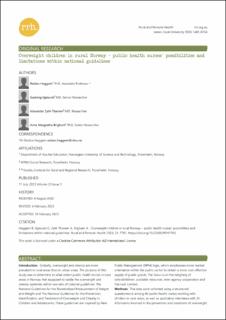| dc.description.abstract | Introduction: Globally, overweight and obesity are more prevalent in rural areas than in urban areas. The purpose of this study was to determine to what extent public health nurses in rural areas in Norway feel equipped to tackle the overweight and obesity epidemic within two sets of national guidelines: The National Guidelines for the Standardized Measurement of Height and Weight and The National Guidelines for the Prevention, Identification, and Treatment of Overweight and Obesity in Children and Adolescents. These guidelines are inspired by New Public Management (NPM) logic, which emphasises more market orientation within the public sector to obtain a more cost-effective supply of public goods. The focus is on the weighing of schoolchildren, available resources, inter-agency cooperation and the rural context.
Methods: The data were collected using a structured questionnaire among 40 public health nurses working with children in rural areas, as well as qualitative interviews with 25 informants involved in the prevention and treatment of overweight and obesity among rural children.
Results: The study shows that rural public health nurses worry about the lack of resources for follow-up with children with a body mass index greater than what is characterised as ‘normal’. The public health nurses suggested better cooperation between different stakeholders to work around the lack of resources and at the same time be able to see the whole picture, considering that overweight and obesity are complex problems connected to different challenges. They believed that it is an advantage to see the individuals in their local surroundings, to know their family history, their leisure activities and so on. This might be easier in rural areas than in urban areas, as these areas are often more transparent.
Conclusion: There was consensus among the public health nurses involved in this study that national guidelines for treating overweight and obesity in children with the principles of NPM, and simplifying and standardising services, adds challenges instead of solutions. Such practices also hinder the use of experience-based knowledge about both the individual and the local context. There is a need for more flexible guidelines that can easily be adapted to the local (rural) context. | en_US |

